Jun 4, 2016 | coins, counterfeit, education
This is part 4 of a 6 part series
Specific gravity is a way to determine the density of an object—or in this case, a coin. The denser an object is, the heavier it feels. In plain language, the density of an object describes how many molecules are packed together in the area. Since gold is one of the densest materials, gold feels heavier than it looks.

Basic illustration of measuring for Specific Gravity.
To do this test, you need a scale accurate to 1/100th gram, distilled water, a clean container to hold the water, and some way to suspend the coin in the water that does not add to its weight. One way to suspend the coin would be to create a suspension system using sewing thread to make a harness that will hold the coin parallel to the scale, and something to hold up the coin. If you use something other than thread that would add weight and displace more water, you will have to account for the harness. A wooden dowel can be used and laid across two stacks of books or bricks that are of the same height.
First, weigh the coin before doing anything else to get a reference “dry” weight. Then place the coin in the harness, suspend it over the scale, and with the empty container on the scale. Note where the coin sits in the container then remove the coin. Fill the container with distilled water so that it would be about a half-inch higher than the coin then tare the scale—set the weight so that it reads zero.
Now take the suspension system and carefully suspend the coin in the water. When the coin settles in the water, check the side facing down for air bubbles. If there are air bubbles, carefully tilt the coin using the thread to release the bubbles. One way to do this is to grab the threads of the harness with tweezers.
When the coin is still, the weight showing on the scale is weight of the water that was displaced when you suspended the coin in the water. Then you can calculate the specific gravity of the coin by dividing the dry weight by the weight of the displaced water (or dry weight/wet weight). Now you have the specific gravity of the coin.
This calculation may be deceiving because the coin may not be a solid value. An additional calculation would have to be made to account for the other metals in the coin, or you can search the Internet to find tables of the expected specific gravity for the coin you are testing.
Once you have the specific gravity, it should be within .02 percent of the reference value. If it is out of that range, the coin is likely a counterfeit. One way counterfeiters try to fool buyers is to use a lead-based core and plate the coin with the metal. Since lead is lighter than gold and heavier than silver, measuring the specific gravity will tell you if the metal used is the right one.
The following is a good video showing how you can do a basic home test for specific gravity:
Basic Reference
To help you with your tests, the following table will help you with the specific gravity of United States coins:
| Coin Type |
Alloy |
Specific Gravity |
| American Platinum Eagle Bullion |
.9995 PI |
21.40 |
| All 24-karat gold coins |
.9999 Au |
19.32 |
| American Gold Eagle Bullion |
.9167 Au, .30 Ag, .533 Cu |
17.45 |
| Early Gold Eagles |
.9167 Au, .0833 Ag+Cu |
17.45 |
| Gold Coins |
.900 Au, .100 Cu |
17.16 |
| Classic Head Gold Coins |
.8992 Au, .1008 Au |
17.14 |
| American Silver Eagle Bullion |
.999 Ag |
10.50 |
| Silver Coins |
.900 Ag, .100 Cu |
10.34 |
| Early Silver Coins |
.8924 Ag, .1076 Cu |
10.32 |
| Silver Trime |
.75 Ag, .25 Cu |
10.11 |
| Silver Clad Halves |
.400 Ag, .600 Cu |
9.53 |
| War Nickels |
.56 Cu, .35 Ag, .09 Mn |
9.25 |
| Clad Coinage |
.75 Cu, .25 Ni |
8.92 |
| Early Copper Coins |
1.00 Cu |
8.92 |
| Early Small Cents |
.88 Cu, .12 Ni |
8.92 |
| Bronze Cents |
.95 Cu, .05 Zn+Sn |
8.84 |
| Later Bronze Cents |
.95 Cu, .05 Zn |
8.84 |
| Modern Small Dollars |
.77 Cu, .12 Zn, .07 Mn, .04 Ni |
8.78 |
| Steel Cents |
Zinc-plated steel |
7.80 |
| Post 1982 Cents |
.975 Zn, .025 Cu |
7.17 |
Chemical symbols used:
- Ag: Silver
- Au: Gold
- Cu: Copper
- Mn: Manganese
- Ni: Nickel
- Pl: Platinum
In the next installment, we look at the visual inspection of currency.
Jun 3, 2016 | coins, counterfeit, education
This is part 3 of a 6 part series
Check the Coin’s Weight
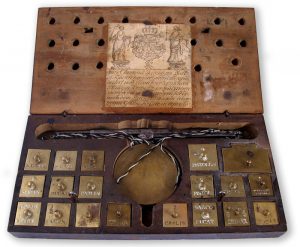
German “Bergische” Coin Balance and Weights 1765 by Johann Phillip Herbertz.
You will also need an authoritative reference that lists the weight of the coin you are weighing.
Weigh the coin. If you put anything on the scale other than the coin, such as a lint-free cloth to protect the coin, make sure you zero-out the scale before weighing the coin—called setting the tare. Your coin should be no more than one percent heavier than its reference weight and no lighter than 2-3 percent lighter for wear.
While the U.S. Mint has tried to be precise in making their coins, early attempts have been less than perfect. I have seen genuine circulated Large cents that have been heavier than the reference weight. Also, it is difficult to know how much of the coin is really worn. A coin that is too light may be a sign that the coin is made of a lighter metal, indicating a counterfeit.
Measure the Diameter and Thickness
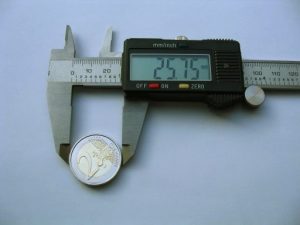
Digital caliper measuring a €2 coin.
Caliper rules can either be made using a mechanical dial or a digital readout with the rule marked to use a visual inspection. I prefer using a digital caliper that is accurate to at least one-tenth of a millimeter.
When you consult a reference to find the dimensions of a coin, you will find that most of the dimensions are in millimeters. It is very important that you remember this and use this scale when performing your own measurements.
To measure the diameter of the coin, hold the coin in your hand—wearing a cotton glove is optional—and make sure the claw end of the caliper fits snugly on the widest area of the coin. Once the measurement is set, you can read the measurement on the dial or digital display.
Do the same thing to measure the thickness.
A genuine coin will be within one percent of the diameter and the thickness will be 1-2 percent of the documented thickness depending on wear. However, this may not be a good test for early copper coins—Large cents and half cents. While congress and the U.S. Mint set standards for these coins, the lack of domestic suppliers forced them to have to buy the blanks from companies in England. Although specifications were provided, suppliers did not follow those standards properly. Many blanks were more like the British penny than based on the U.S. standard. You may find that some early large and half cents are larger in diameter or thicker than the information you find in some references.
Remember, wear and minting conditions can cause variations in these dimensions. It should be one part of the over all assessment.
Magnetism
If a coin is not made of an iron alloy, such as steel, then it should not be attracted to a magnet. Currently, all U.S. coins except for the 1943 Steel cents should not be attracted to a magnet. If the coin is attracted to a magnet, it might be made from a plated steel blank that was made to look like a genuine coin.
Counterfeiting technology has improved to where the counterfeiters are not using steel. Since there may be older counterfeits available on the market, this is a good test to find them.
Although the tests that are being discussed are nondestructive, for lesser coins or bullion, another test that can be used for silver coins is the magnetic slide test. The slide test can scratch your coin and is not recommended for those expensive collectibles.
The slide test uses a small slide that sits at a 45-degree angle from your surface and is made from a rare-earth magnet. Place the coin at the top of the slide and let if fall. If it is a genuine silver coin, it will slowly fall down the slide as if there was resistance. A counterfeit coin made without silver or that may be silver plated will either freely fall down the slide or slow slightly. If the coin is made of a magnetic metal, it will stick to the slide.
This happens because silver is a diamagnetic metal. A diamagnetic metal repels the magnetic field in a way that causes the field to surround the metal. The magnetic field causes a temporary charge to the silver that prevents the field from being repelled as in the case when you try to touch like-poles of a bar magnet. For the sliding coin, imagine that the magnetic field from the slide is forming an envelope around the coin as a type of electronic parachute slowing its fall.
Neodymium magnets are popular choices for all sorts of projects including those that use diamagnetic metals to show an object floating over a surface.
One problem with the slide test is that copper is also a diamagnetic metal. While copper’s diamagnetic properties are not as strong as silver’s, a silver-plated copper coin can fool the slide test. A test that shows the expected behavior but is not correct is called a false positive result.
Acoustic Ring
I remember when I was young and I learned how to rub the lip of a crystal drinking glass to make it sing. I also learned that this only worked for crystal and not the drinking glasses we used every day. It was amazing to try filling glasses with different amounts of water to make different sounds. Then I became discouraged when I saw someone play music using many crystal glasses on a variety show.
Gold and silver coins make a distinctive ring when struck. Wearing a cotton glove, balance the coin on the tip of your finger and strike it with a similar coin and listen to the ring. Wearing a glove prevents the oils on your finger from damaging the coin and prevents your skin from dulling the sound. Compare what you hear using a similar coin of the same type and similar wear. Sometimes this is called the “ping test.”
Of course conditions can change the sound, but if the sounds were drastically different, it would be a reason to question the coin’s authenticity. If this test is another failure amongst all of the others you conducted, you likely found a counterfeit coin.
In the next installment, we discuss a more complicated test called measuring for specific gravity.
Jun 2, 2016 | coins, counterfeit, education
This is part 2 of a 6 part series:

An example of a Morgan Dollar cut in half to match a date with a mintmark to have the coin appear something it is not.
Although laws are being proposed to help combat the problem, you should take the time to examine the coin, especially if you question its authenticity. Remember, none of these tests are fool proof and failing any one does not mean you have a counterfeit coin. You have to take all the evidence in its entirety to determine if the coin is real or not.
Before you look at the coin, you should be very familiar with the type or have a version of the coin you know to be authentic to compare with it. Although it would be easier of the coin was not in a grading service holder for visual comparison, at least you have a reasonable certainty that an encapsulated coin is authentic.
It helps to have a good magnifier to use to inspect your coin and cotton gloves to prevent the oils from your skin sticking to your prized collectibles.
Orientation
As you look at the coin, flip it over and look at both the obverse and reverse. How is the alignment of the coin? If you are looking at United States coins, you should be able turn it over and the reverse are in the opposite direction of the obverse. This is called “coin alignment.” Some countries produce coins in what is called “medal alignment” where the top of the obverse and reverse designs are in the same direction.
Just because a coin’s alignment is off does not mean the coin is a counterfeit. It is possible that the coin is genuine but was struck by misaligned dies to cause this error. Otherwise, keep the information in the back of your mind as you examine the rest of the coin.
-

-
U.S. coins are struck using coin orientation where if you looked at the reverse in a mirror, the reverse would look upside down.
-
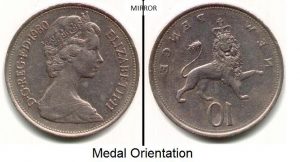
-
Some countries strike their coins using medal orientation where if you looked at the reverse in a mirror, the reverse would look right side up.
Examining the Edge
The edge of the coin is also known as the coin’s third side and the most underestimated area to look. Check the edge for a possible seam that could be the sign of a counterfeit that was cast in a mold rather than struck by a press. Also look for filing or other marks that would suggest the seams were smoothed.

Detecting counterfeit £1 coins, the genuine coin has edge lettering (left), the counterfeit does not.
With the recent rash of counterfeit British £1 coins, we learned that an easy way to tell the fakes from the real coins is to check the edge. If the coin’s edge does not include lettering, the coin is likely a counterfeit.
Surface Examination
Another clue to look for is if there seems to be a surface added to a coin. It will appear like someone put a veneer on top of a metal core. Coins should appear to be solid disks of metal. Even bimetallic coins look and feel like solid coins, even though they are made of two different parts. If you see this veneer-like effect, it is likely that the coin is a counterfeit.
Does the coin supposed to have edge lettering? Remember, some early varieties have coins that have edge lettering, while a later variety has reeds. Make sure you know which version of the coin you are examining and if the lettering on the edge matches the style of a genuine example. Collectors of Presidential dollars know that the lack of edge lettering can be an error by the U.S. Mint and not the sign of a counterfeit.
Some foreign coins have small tooth-like extensions on the surface near the coin’s edge called denticles. While the look of denticles could be different as the die wears, denticles on genuine coins have a sharp, consistent design. Denticles on counterfeit coins may be rounder, more inconsistent, and less dense on the coin—similar to reeded edges. This is where having a good knowledge of the coin you are examining will help you tell the difference between worn denticles produced by worn dies and a counterfeit coin.
Examine the legends and other features of the coin. Do the fonts look right? Is the image proper? Are these elements in the right places? While mistakes happen, it is extremely rare, if not impossible, for many of these elements to be off because of the way all mints make the dies. If the features are consistently incorrect, then the coin is likely to be a counterfeit.
What does the surface look like? Is it dull or have a dull appearance even though the coin is supposed to be of a higher grade? Are the features sharp or do they look rounded? Does the relief of the design look right or is it too flat? If the coin is supposed to be of a higher grade, the sharpness of the detail is important. Although there are coins that were not struck very well, called weak strikes, they will have sharper details than most counterfeit coins.
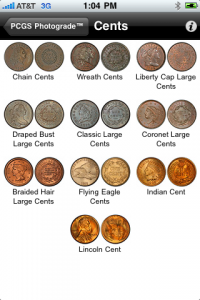
Click image to read my reviews of PCGS Photograde
On some coins you can see the evidence of the metal flow from the striking process. For some coins, it gives the coin a distinct look—like large silver dollars whose surface gives what is described as a “cartwheel effect” when examined under bright light. Be careful with this test because a lower grade coin has had its surface worn and will not show the cartwheel effect.
If the coin is a cast counterfeit, the surface may look bubbly. While there are examples of planchet (the coin blank) errors where the surface may bubble, these are usually in a small area and looks like small pimples on the coin. A bubbly surface from a cast coin may look similar to the gelatin mold you made where air became trapped inside.
Another sign of a counterfeit coin would be the showing of a different metal under a worn area. If the coin is supposed to be silver but a different color is showing through on a worn area, then it is likely that the coin was plated to give the appearance of silver but was made of a less expensive metal.
Check for Alterations
Finally, check for date and mintmark altering. On a genuine coin, the date and the mint mark looks like it is part of the coin and appears to be “growing” out of the surface. On a counterfeit coin, there are many ways to alter these elements by carving the date, called tooling, or physically cutting the elements from another coin and attaching it to a real coin. This type of alteration is common to change or add a mintmark to a coin.
Use your magnifier to look carefully at the date and mintmark. If there are too many sharp edges or looks damaged from being cut, I would be wary of the coin. Look at the mintmark and the potential grime around it. Does the placement of that grime look like it could have been accumulated over the years of circulation? Or does the pattern of grime not look natural and could be covering up a possible alteration?
-

-
Altering the mintmark and adding “V.D.B” to the reverse of a coin is another trick to fool the buyer.
-
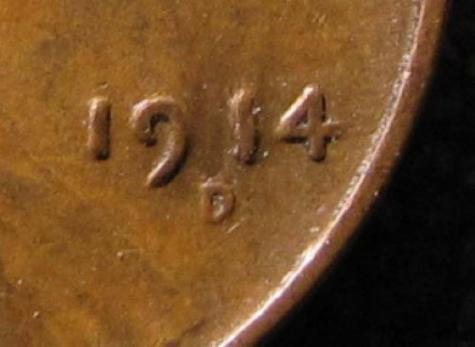
-
Look closely at the mintmark, it is clearly altered from the S you can see shadowed.
Also, know the difference between altered coins and genuine coins where the date was altered in the dies or the mintmark was repunched. Before express travel and fast package shipments, there were times when a branch mint needed to alter dies from another mint or alter dates on the dies so they can continue to strike coins. Rather than filling the die and punching the new date, the coiner would use a punch with the proper number and try to strike it in a way to eliminate most of the previous date. Repunched dates, also called over dates, were more common for coins struck outside of Philadelphia, but have happened in Philadelphia. When you see a catalog listing about a coin with a repunched date, it is written as the date of the coin followed by a forward slash followed by the digits that was previously on the coin. For example, in 1942, the Philadelphia Mint accidentally pressed a 1942 hub with 1941 dies creating the 1942/1 over date that were used in Philadelphia and Denver. Finding one in the lowest grade is worth a lot of money giving counterfeiters a good reason for counterfeiters to try to make one.
If you find a coin that looks like one mintmark is on top of another, or a mintmark looks doubled or tripled, it may be because it is a repunched mintmark. In addition to branch mint sharing dies, dies were shipped from Philadelphia without mintmarks. It was the job of the chief coiner in each branch mint to punch the mintmark into the dies. Sometimes the punch moves when struck giving it a doubled or tripled look. Other times a mintmark filled on the dies and another mintmark is punched over. Re-punched mintmarks are written the same as over dates in the catalogs.
One of the more famous re-punched mintmarks is the 1900-O/CC Morgan dollar. In this case, after the Carson City Mint was closed (CC mintmark), the reverse dies were shipped to the New Orleans Mint (O mintmark). The dies were filed and filled so that the “O” mintmark could be punched on the reverse but whoever did the work did not completely remove the “CC” mintmark. Looking under magnification, you can see the shadow of the original “CC” mintmark that was on the die.
Re-punched dates and mintmarks occurred more often than the U.S. Mint would like to admit. If the coin you are examining has one of these errors, check a reference to see if the it is known. While not finding it in a reference does not mean the coin is counterfeit, it is enough evidence to question whether the coin is genuine of counterfeit.
In the next installment, we discuss what to look for in weight and measurements.
Jun 1, 2016 | coins, counterfeit, education
Detecting Counterfeits
This is first article of a 6 part series:
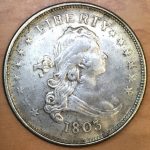
This counterfeit 1803-dated dollar was recently offered in a Hong Kong flea market for less than $3.
There has been a rise in counterfeiting of both collectible and circulating coins. The biggest source of counterfeit collectable coins has come from China. In some cases the counterfeiters had purchased the presses and other machines from the U.S. Mint and other government mints after they were replaced with more modern machines through government surplus sales, providing a supply of machines that could strike high quality coins.
To add to the problem, at one time the U.S. Mint did not fully deface used dies after its useful life. Rather, they would carve an “X” in the surface leaving large areas of the design showing. These cancelled dies made it out of the various branch mints as souvenirs and have been available on the open market. Counterfeiters have purchased these dies, mostly Morgan dollars, and use them as the basis to create their own dies that have fooled even the most experience numismatist.
Today, the U.S. Mint grinds the design completely off of all cancelled dies.
Starting in 2010, Great Britain began having problems with counterfeit £1 coins entering circulation. Even though the British law enforcement community has explained how to detect counterfeit £1 coins, they continue to fool the public. Although arrests were made in the rural areas of Great Britain in 2012, it is estimated that one in 30 £1 coins in circulation are counterfeit.
In 2017, the Royal Mint will issue a bi-metallic 12-sided £1 coin with anti-counterfeiting micro-engraving and milled edges to deter counterfeiting.

Detecting counterfeit £ coins, the genuine coin has edge lettering (left), the counterfeit does not.

In 2017 the Royal Mint will issue a bi-metalic 12-sided coin with microprinting.
Throughout the rest of Europe, they have been fighting against counterfeit €2 coins. Counterfeiters in Greece and Turkey had access to surplus presses and other material to strike a coin that looked very similar to standard €2 with the standard Greece reverse. News reports speculate that the coins were made with stolen material.

Counterfeit €2 coins were found in Italy.
To prevent counterfeiting, the Royal Canadian Mint (RCM) has introduced laser micro-engraving to their new $1 (Loonie) and $2 (Toonie) coins. On the $1 coin, a circle above the image of the common loon on the reverse is micro-engraved with an image of a maple leaf. On the reverse of the $2 coin, there are two circular micro-engraved images of a maple leaf and a virtual image using an angled design at the top of the design. The RCM hopes these fine details added to the Loonie and Toonie will prevent them from being counterfeited.
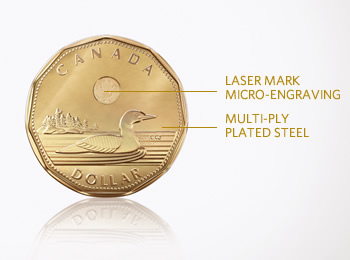
New anti-counterfeiting features of the Canadian dollar coin.
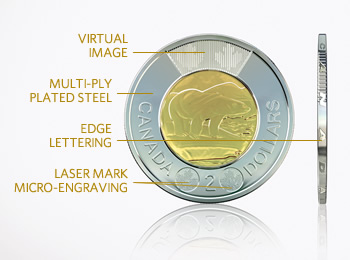
New anti-counterfeiting features of the Canadian two-dollar coin.
The U.S. Mint does not have plans or the legal mandate to include anti-counterfeiting measures on coins. This may be because the dollar coin does not circulate in the United States and the cost of counterfeiting lower denominations are too expensive to be profitable. However, that does not mean that it will not be a possible to profitably counterfeit United States coins in the future.
There are ways to do your own testing to see whether the coin you are questioning is real or counterfeit. In the next installment, we discuss what to think about when visually examining your collectible coins.
Credits
- Image of counterfeit 1803 dollar courtesy of Donn Perlman.
- Image of counterfeit UK pound coin courtesy of BBC News
- Image of the new £1 coin to be issued in 2017 courtesy of the Royal Mint
- Image of counterfeit €2 coin courtesy of The Daily Mail
- Images of the Canadian coins courtesy of the Royal Canadian Mint
May 7, 2016 | coins, counterfeit, news
Europe is experiencing a rise in counterfeiting circulating coins that governments are saying is causing additional damage to economies. Coins that are experiencing a rise in counterfeiting include the British one-pound coin that will be replaced in 2017, the Swiss 5 franc coin, and the 2-euro coin. While the source of the British counterfeits remain a mystery to law enforcement, reports suspect that Swiss and euro coins are being manufactured in Italy.
In the United States a new wave of collector coins and bullion have been seen in the market. The Professional Numismatic Guild is reporting that following a survey of its member dealers the number of counterfeit coins now on the market is on the risk. In addition to the counterfeit coins many are appearing in counterfeit grading service holders. While an experienced collector may be able to detect most counterfeit slabs, there have been novices who have been fooled by these fakes.
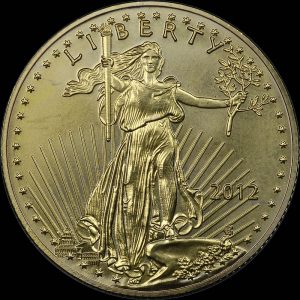
Obverse of a counterfeit 2012-dated American Eagle $50 denomination one-ounce gold bullion coin.

Reverse of a counterfeit 2012-dated American Eagle $50 denomination one-ounce gold bullion coin.
According to PNG, two members who recently were in Asia say they saw counterfeits of Draped Bust, Seated Liberty, Morgan and Peace silver dollars being sold in flea markets in China and Hong Kong for $1 to $3 each. Some are brought back to the United States where they are submitted to third-party grading services where they are returned as counterfeit.

Historic, genuine 1803 Draped Bust design U.S. silver dollars in Very Fine condition are currently valued at about $3,000. This counterfeit 1803-dated dollar was recently offered in a Hong Kong flea market for less than $3.
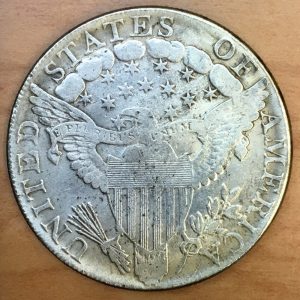
Historic, genuine 1803 Draped Bust design U.S. silver dollars in Very Fine condition are currently valued at about $3,000. This counterfeit 1803-dated dollar was recently offered in a Hong Kong flea market for less than $3.
Many of these counterfeit coins have flaws that someone with experience with these series would easily detect. PNG advises everyone that if you are not sure about the coin, collectors are advised to consult with a PNG dealer who can provide a proper analysis.
While I am not an expert in detecting counterfeit coins, one thing that I notice is that counterfeit modern coins always look too sharp. Their lines are very sharp giving the coins a nearly plastic look. The problem is that gold is a ductile, softer metal which lends to a rounder, more flowing designs when struck. Harder metals can be struck with very sharp edges.
For older coins, aside from design mistakes made by counterfeiters, these coins always have a mushy look to them. While worn coins do not have the struck look to them, they do not wear to where it appears that they were originally struck underwater.
If there are any questions about the authenticity of a coin, always consult a trusted dealer!
Here is the press release issued by PNG:
Use Caution To Avoid Gold And Silver Counterfeits,
Advises Professional Numismatists Guild
(Temecula, California) – Beware of counterfeit vintage rare coins and fake modern gold and silver bullion items now being offered in the marketplace. Purchase only from reputable dealers, cautions the Professional Numismatists Guild (www.PNGdealers.org).
The PNG is a nonprofit organization composed of many of the country’s top numismatic experts.
“It is clear there is an increase in the types of fakes sold by unscrupulous dealers. These sales of counterfeit coins are potentially a multi-million dollar problem for the public. There’s an old saying that can help buyers avoid problems: If you don’t know coins, you better know your dealer,” stated Professional Numismatists Guild (PNG) President Dana Samuelson.
“We conducted an informal inquiry of PNG members and PNG Accredited Precious Metals Dealers (APMD) about what they’re encountering now in the marketplace. They have seen everything from counterfeits of vintage rare coins to modern precious metal items. These include fakes of popular century-old U.S. Morgan and Peace design silver dollars to current gold and silver American Eagles, gold U.S. Buffalo coins, silver and gold Chinese Pandas, and Canadian silver and gold Maple Leaf coins. We’re also seeing spurious gold and silver ingots,” said Samuelson.
“Professional dealers who look at classic U.S. coins and bullion items all day long are usually not fooled by these spurious items, but to the untrained eye they often look like the real thing,” he explained.
“Many of the fakes apparently are originating in China and then offered online by various sellers. It is imperative that collectors, investors and the general public deal only with reputable, knowledgeable experts who offer a guarantee of authenticity,” emphasized Samuelson.
Two PNG members who recently were in Asia say they saw counterfeits of early 19th century Draped Bust, mid 19th century Seated Liberty and late 19th and early 20th century Morgan and Peace silver dollars being sold in flea markets in China and Hong Kong for $1 to $3 each.
Unsuspecting buyers have submitted counterfeit modern bullion coins to Numismatic Guaranty Corporation (www.NGCcoin.com) for authentication and grading. NGC, the official grading service of PNG, earlier reported submissions of counterfeit 2012-dated gold American Eagle $50 denomination coins.
Those particular counterfeits exhibit poorly defined details around Liberty’s face and hair, different fonts for lettering and the date compared to genuine coins and the color is different because the fakes are not composed of gold, according to Max Spiegel, a Vice President of Certified Collectibles Group, NGC’s parent company.
PNG and PNG Accredited Precious Metals Dealers must adhere to a strict Code of Ethics in the buying and selling of numismatic merchandise including bullion coins, precious metal rounds and ingots, and they offer a guarantee of authenticity for the numismatic items they sell.
For a list of PNG-APMD members visit www.PNGdealers.org and click on the APMD navigation link.
Nov 13, 2015 | coins, commentary, counterfeit, news

The counterfeit quarter-ounce Krugerrand in a counterfeit NGC holder that was purchased in Fullerton, California.
The biggest threat to the numismatics industry is not the lack of participation by younger people, women, or people of color, all of which are problems, the threat that counterfeits pose will drive away potential collector and investors. Anyone that collects scarce or rare coins should be very concerned about counterfeits.
Industry heavyweight Dwight Manley issued a statement after his company was fooled by a counterfeit Krugerrand in a counterfeit third-party grading service holder. Here is the statement:
Beware of Frighteningly Deceptive Counterfeits
Statement By Dwight Manley
Prominent rare coin dealer and collector Dwight Manley, owner of Fullerton Coins & Stamps in Fullerton, California and Managing Partner of the California Gold Marketing Group, who assisted a quarter-century ago in breaking up a counterfeit coin and counterfeit holder scheme, has issued the following statement.
“A frighteningly deceptive counterfeit has been encountered, and the world needs to be told about it. We recently realized that a 2005-dated quarter-ounce South African Krugerrand labeled NGC Proof 70 is not only a counterfeit coin, it is housed in a counterfeit Numismatic Guaranty Corporation holder that has the same certification number on the label as a genuine 2005 PF 70 one-quarter ounce Krugerrand listed in the NGC data base.”
“The fake was purchased on October 23, 2015 by a knowledgeable employee of Fullerton Coins & Stamps over the counter from a semi-regular customer. Before making the purchase, the employee checked the NGC website to see if the certification number and coin description matched. They did: cert number 3676849-006.”
“I recently examined the coin, and it just didn’t look quite right. I did a side-by-side, inch-by-inch comparison between the encapsulated coin the store purchased and the obverse and reverse photos on the NGC website. The reproduction of the NGC hologram on the fake is almost dead on the same; however, there is one distinct difference between fake and genuine on the left side of the front insert label. On the fake coin, the circle in the NGC logo (an encircled balance scale) goes almost entirely around the P in the grade PF 70. On the genuine coin’s label, the P is outside the logo circle.”
“An amazing amount of effort obviously went into creating a fake coin and a fake holder with a cert number and description that match a genuine coin. I’ve notified NGC, but in the meantime, I caution collectors and dealers to watch out for any similar, deceitful and dangerous counterfeits.”
Jan 19, 2015 | BEP, counterfeit, currency, Federal Reserve
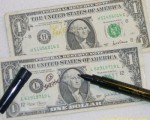
How an iodine pen reacts depends on the type of paper used.
As I was waiting to checkout, the person running the cash register was having difficulties with someone whose credit card was not being accepted. It did not matter what the problem was, the issue was holding up the line. While waiting, the gentleman next on line turned to me and said, “This is why I pay in cash.”
Apparently, my fellow line waiter and I had one thing in common, we both visited the bank prior to doing our shopping. He paid for his purchase with crisp, new currency. Just like my new currency, they were mostly $20 Federal Reserve Notes in serial number order fresh from a pack that was opened in the bank.
When the cashier counted the money, she picked up a pen and drew a line on each note. The pen was a counterfeit detection pen that contains an iodine-based ink used to determine whether the paper used is counterfeit.
These iodine pens test whether the paper is legitimate by checking if the iodine reacts with the starch that is used in commercial paper to make them look brighter. If the paper contains starch, then the ink turns dark indicating the paper is not real currency paper. Otherwise, the mark stays amber on the normal cotton bond paper.
There are two problems with this method of counterfeit detection. First, it is relatively easy to defeat the iodine pen by washing and bleaching a low denomination bill and reprinting a higher denomination on the same paper. By using legitimate currency paper, testing it with the iodine pen will not detect that it is counterfeit.
I remember there was a story on one of the television networks about how counterfeiters bleached $5 notes and passed them off as $20 notes after reprinting them. While searching, I found the following video of NBC’s Chris Hanson as he reported about this on Dateline:
Another problem with using iodine pens is that merchants that use them put their customers in danger who have iodine allergies. Those of us with severe iodine allergies can experience anaphylaxis, a serious reaction whose rapid onset can be so severe that it can cause death. As one of those people with severe iodine allergies, I watched this scene in horror.
Following a discussion with the manager, I consented to using a credit card since this was not one of those retailers that have been in the news for being hacked.
After all the Bureau of Engraving and Printing does to ensure that the new currency is more difficult to counterfeit and how the criminals are getting around these iodine pens by using real currency paper, it is incredible to think that these stores are still using tried but untrue measures for counterfeit detection.
In the meantime, the more serious counterfeiters are bleaching and overprinting $5 notes because as the criminal in the video says, nobody looks!
Jan 10, 2015 | bullion, counterfeit, gold, legal, news, scams
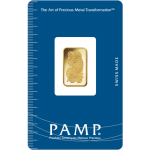
PAMP Gold Ingot
Traveling Suspects Arrested
Two suspects have been arrested for selling fake Suisse Pamp carded gold bars (2.5gm, 5gm,10gm and 1 ounce) at a coin shop in Greenwood, Indiana. Search of the suspects vehicle revealed multiple identification cards, business and pamphlets from different coin shops and an additional 250 fake gold bars and coins. Based upon receipts located in the vehicle the suspects had been selling the fake gold to shops in Illinois, Kentucky, Tennessee and Indiana since September, 2014.
The suspects were driving a silver Ford Focus with Missouri license plates. The suspects are being held for Theft by Deception.
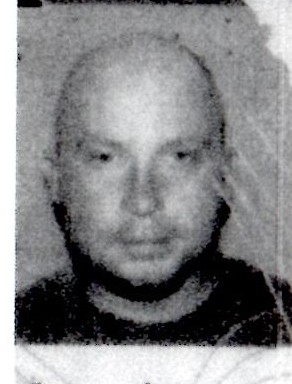
Aaron Taylor
Western Union, IL
Second suspect was identified as Nelson Hernandez (No photo available) alias Benjamin Wade.
Anyone having been in contact with either of these subjects should contact:
Doug Davis, 817-723-7231,
Doug@numismaticcrimes.org
If you have information, please contact Doug Davis. Let’s keep the hobby for both collectors and investors safe!
Dec 20, 2014 | coins, counterfeit, legislative
With the midterm elections behind and the anticipation of the changes, congress still had work to do in the lame duck session. Over the last few sessions, congress has been their most productive during lame duck session as polling and focus groups has lead to those running for re-election to fearing the fast moving news cycles. Even the least controversial measures can be side tracked when members think that someone is watching that could misconstrue even the best of intentions.
But good things come to those who wait. Monday afternoon, December 15, 2014, H.R. 2754, the Collectible Coin Protection Act was passed in the Senate. The bill is on the way to the White House for President Obama’s signature, which should be a formality. The Collectible Coin Protection Act was first introduced to in the U.S. House of Representatives on May 7, 2013 to amend and updates the Hobby Protection Act that was passed over 30 years ago. The new law will allow law enforcement to take criminal action and individuals to take civil action against manufacturers, importers, and sellers of counterfeit coins and bullion products. It also allows the enforcement against the unauthorized use of registered trademarks belonging to collectible certification services.
Given the changes in the way we do business today, one of the more significant issues with the Hobby Protection Act is that only the manufacturers of the counterfeits could be prosecuted. In most cases, the manufactures of these counterfeits are hiding behind the Great Wall out of the legal reach of United States law enforcement. The Collectible Coin Protection Act will update the law to add the sellers and distribution of those coins to the targets of enforcement. If we cannot get to the makers of these fakes, then those who distribute that contraband can be prosecuted.
Further expanding the legal net to catch the scofflaws is the new provision to include “any person who provides substantial assistance or support to any manufacturer, importer, or seller” who knowingly engages in any act that violates this law. In other words, this adds the accomplices and those who support any part of the act of production and selling counterfeit United State coins.
If you buy a counterfeit coins, you can now take action against the the counterfeiter, their agents, the seller, and anyone else in the supply chain who was involved in the manufacture and sale of the coin. Even if you unwhittingly buy the counterfeit coin via an online auction and attempt to flip it hoping to recover your money, the buyer can sue you as the seller of contraband. To help fight the counterfeiting of third-party certification service holders, the act extends trademark violation and the ability to sue for remedies.
These new provisions will allow collectors, dealers, and grading services to bring legal actions that are much more effective, with much stronger remedies than previously existed. It will allow those harmed to work with the Justice Department to bring criminal actions where appropriate.
Congress engrossed the bill and sent it to the White House on December 15, 2014. It is currently waiting for President Obama’s signature. It will be a good present to the holiday when he signs this bill into law.
Examples of Chinese Counterfeits
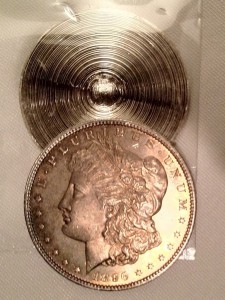
An example of a Morgan Dollar cut in half to match a date with a mintmark to have the coin appear something it is not. Coin was in a counterfeit PCGS slab and caught by one of their graders.

PCGS representatives showed Congressmen counterfeit U.S. coins in counterfeit PCGS holders during their recent meetings in Washington, DC. (Photo courtesy of PCGS.)
Oct 7, 2014 | BEP, coins, counterfeit, currency, gold, policy, US Mint
Prior to the public disclosure of secret documents, administrations have declassified documents at various levels for many different reasons that those of us who worked in these areas did not understand what was to be classified at what levels and for how long. Each department and agency had its own rule. However, everything that was classified was supposed to be declassified after 50 years.
In 2009, President Obama issued Executive Order 13526 to try to create some order out of this chaos. Aside from defining the classification levels, document marking requirements, it also allowed agencies to apply to keep documents classified and for longer periods than previous reviews. The purpose was to protect national interests and security while preventing controversial declassification of documents.
Whenever trying to instill a new policy on the government, there will be many barriers to this change. While there are fewer areas of confusion, chaos remains. Of course the disclosures by Chelsea (neé Bradley) Manning and Edward Snowden did not help.
So what does this have to do with numismatics? Both the U.S. Mint and the Bureau of Engraving and Printing applied and were granted exemption from automatically declassifying documents.
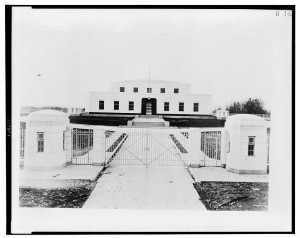
Treasury Department, Procurement Division, Public Buildings Branch, Fort Knox – United States Bullion Depository (1939)
What information could these agencies possibly have that would be classified?
According to Steven Aftergood, Director of the Federation of American Scientist Project on Government Secrecy, who interviewed John P. Fitzpatrick, director of the ISOO, the exemption for the U.S. Mint is for “security specifications from the U.S. Bullion Depository at Fort Knox, which was built in the late 1930s.”
In a comedic turn, Mr. Fitzpatrick told Aftergood, “Think ‘Goldfinger’.”
Then why does the Bureau of Engraving and Printing need an exemption from declassification for 25-years? A source familiar with the filing said that the exemption covers counterfeiting information. According to sources, there are anti-counterfeiting measures added to currency that have been planned for many years that have not been advertised. These are used by the United States Secret Service and other law enforcement organizations to detect counterfeiting. Many of the documents cover the planning for the changes that began in the 1990s.
 Sources also confirmed that there were other documents that the BEP and Treasury asked to be included in this exemption but not their general contents. Some hint was given that the classified information concerns long term and ongoing operations against international counterfeiters. Although not confirmed, it is suspected that the classified documents discusses enemy foreign governments actively working to counterfeit United States currency. No country was named but it has been rumored that North Korea has been attempting to counterfeit U.S. currency.
Sources also confirmed that there were other documents that the BEP and Treasury asked to be included in this exemption but not their general contents. Some hint was given that the classified information concerns long term and ongoing operations against international counterfeiters. Although not confirmed, it is suspected that the classified documents discusses enemy foreign governments actively working to counterfeit United States currency. No country was named but it has been rumored that North Korea has been attempting to counterfeit U.S. currency.
And you thought all the U.S. Mint and Bureau of Engraving and Printing did was manufacture money!



























